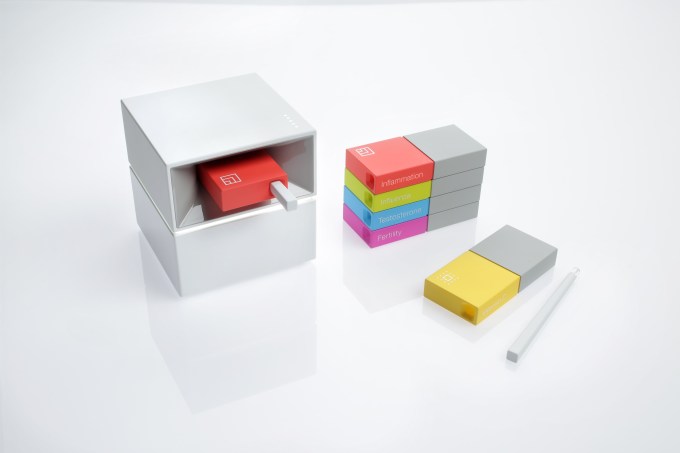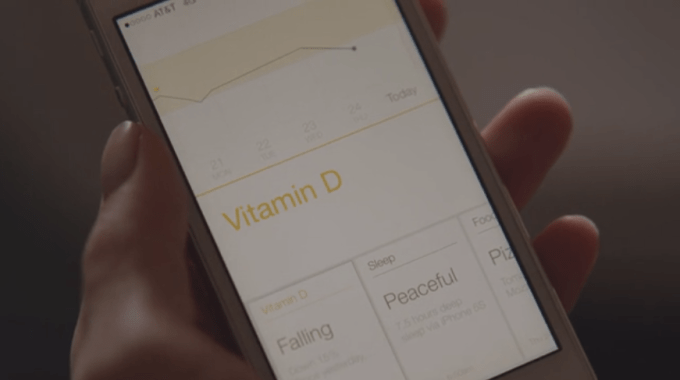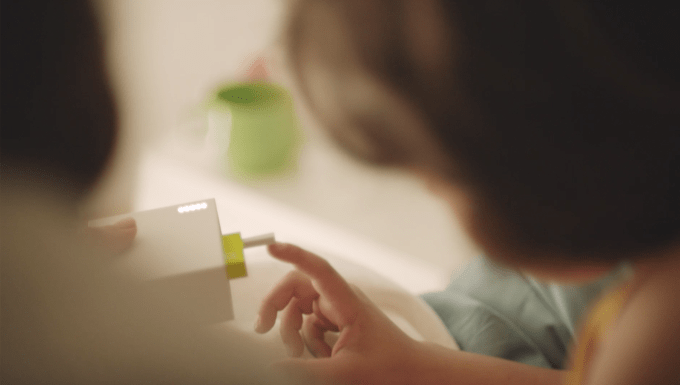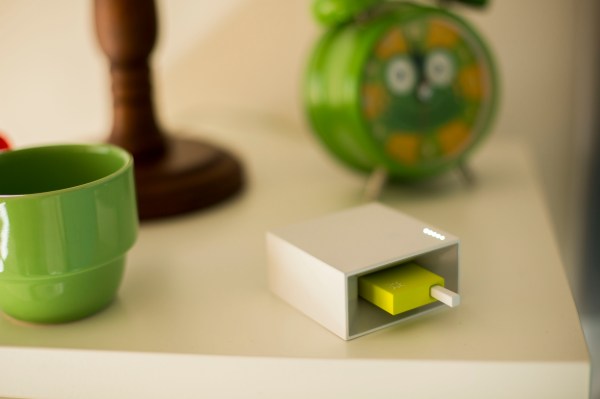The quantified self and quantified health trends frequently overlap — but few startups are quite as tightly screwed into that sticking place as Cue. Not yet anyway.
This San Diego-based startup, which was founded back in 2009 in the midst of the swine flu peak and has attracted more than $1 million in backing from an undisclosed U.S. angel investor, is building a hybrid electronic-mechanical-chemical connected device that it says will enable people to quantify their health at a molecular level.
And, with the help of the corresponding smartphone app, use the resulting data to tweak their lifestyle for the better — whether that’s to identify the most fertile times in their cycle to help them try for a baby. Or push their body to recover faster after a particularly punishing workout. Or identify a vitamin deficiency and tweak their diet to compensate.
The scenario they sketch for Cue is that people are going to be able to run their own ‘before and after’ experiments at home to quantify whether a particular fitness routine or diet is actually having a beneficial result on their own body.
There’s no external lab in this diagnostic loop requiring the user to send off samples. Rather the Cue device itself is the lab, and it lives at home — connecting to your smartphone by Bluetooth to feed data into the Cue app.
Cue’s makers dub it a “deep health tracker” — since it’s actually tracking the user’s health on a molecular level, rather than more remotely monitoring signals like heart rate or blood pressure.

The idea for Cue came after the founders saw how many people were flooding the healthcare system wanting to know whether they had swine flu or not. “All these people were seeking this one piece of information, and we thought that there had to be a much simpler way for people to find out the information without having to stand in a huge emergency room line or wait for a doctor’s appointment,” co-founder Ayub Khattak tells TechCrunch.
“As we developed the technology, we saw that it was highly adaptable to other diagnostic tests run on ELISA kits and realized that there are other health indicators that people might want to have on demand access to, especially related to health and wellness as people seem to have an innate hunger for information about their body and their health.”
So how exactly does Cue work — or rather, what exactly is it doing? “We’ve used some time tested basics, so the things that you find in the lab right now — in particular antibody based, very specific targeting of molecules,” explains Khattak. “That’s how tests are run today at the lab. What we’ve done is we’ve taken that concept — that fundamental principle — and we’ve used biosensors and microfluidics to make it so that we can execute those basics in a very compact, very automated way.
“So what we did is we developed the microfluid technology and the biosensor technology and integrated those together to execute those fundamentals.”
“What the technology is doing is converting a biological sample to an electrical signal or digital result, which then we can take from our device, Cue, and Bluetooth over to the smartphone,” adds Cue’s other co-founder, Clint Sever, breaking the process down further. “This is a fundamental principle of electrochemistry.”

“Another way of saying that is we input a biological sample, it reacts with our chemistry to create an electrical signal which we then take in from our sensor on the cartridge and then that’s now our electrical signal that we translated to a digital result — and then that’s Bluetoothed over to the phone,” adds Khattak.
The pair says the main innovations allowing them to squeeze a lab into a connected cube that’s (relatively) affordably priced are in the area of thermoplastics and fluid handling/microfluidics.
“We’re able to leverage really low cost plastic manufacture,” says Sever. “And then also on the biosensor side we’re able to use stuff that’s already in huge scale in the industry today. And so because of that we’re able to basically combine those elements into a working unit that packages all those fundamentals into a very inexpensive cartridge that’s disposable.
“That’s something that’s never existed before — the scale of the components that we’re able to execute with. And then also the smartphone; just the trend of the smartphone existing and it being such a hub of people’s information and people being comfortable with that. And people putting in different types of data into that so that we can have that context.”
The samples from which Cue draws data — either blood, saliva or nasal swabs, depending on what the user wants to track — are introduced into the device via collection wands, which are inserted into different cartridges, again based on the type of analysis the user wants to perform. If you want to tracking fertility it’s a different cartridge to monitoring inflammation, and so on. The cartridge with the sample wand is then inserted into Cue so the sample can be analyzed and the data sent on to the Cue app.
In the case of the blood sample, required for three of the tests (fertility, inflammation and vitamin D), the collection wand includes a tiny lancet to pierce their skin so the user can harvest a droplet of blood for the test — much like a glucose meter.
There are five initial cartridges for Cue: flu, fertility, testosterone (worth tracking because it has a role in muscle production), Vitamin D and inflammation — but its makers say their the aim is to continue expanding what the system will be able to monitor in future. Albeit, they don’t want to tip their cards on exactly what else is on their roadmap at this early point.
Being able to track and quantify different types of markers in your body is going to be a very fundamentally obvious thing in the near future
“The ultimate vision is anything you can find in a lab today you’re able to access very easily in your own home through Cue,” says Khattak.
“Because of the way we designed it we can plug in different targets for different target molecules into the system and you don’t have to redesign the entire system to accommodate that — you just add that new updated chemistry to the same hardware architecture and you’re able to run multiple different types of analysis on Cue,” adds Sever.
The Cue itself is on pre-order currently, and isn’t due to ship until the first half of 2015 — so everything is vision at this point, although they’ve built working prototypes that they’re confident to take into production. And they’re in the process of gaining FDA clearance.
Returning to the specifics of what the first iteration of the device will be able to monitor, each health condition is being tracked by the identification of a specific molecule.
“With the flu virus we actually look at a protein that’s on the virus itself, actually inside the virus itself. That’s how we do flu. For testosterone there are free testosterone molecules floating around the saliva and serum and that’s what we collect, in the saliva actually. And then with fertility there’s a hormone — it’s called luteinizing hormone — that we can quantify there as well, in the blood,” says Khattak, who brings a background in biochemistry — including three years in a biochemistry lab at UCLA — to the startup.
“And then with Vitamin D it’s a molecule called 25 OH D: 25 hydroxy D3. That is the molecule that we measure from your blood. And the last one is inflammation — inflammation is a systemic response, a lot of things are involved with it, but there’s one marker in particular in particular that is very effective at tracking overall inflammation and that’s called HSCRP. It’s high sensitivity CRP — C-Reactive Protein. And that’s used very often for gauging inflammation from medical professionals.”
Giving an example of why tracking inflammation might be useful, Sever suggests a fitness enthusiast who has been for a particularly long run could use Cue to track how their body recovers from that punishing workout session, and also take steps to speed up recovery time.
“[When you’ve been running] there’s a lot of pressure on your joints, there’s a lot of demand on your muscles and your tendons and your ligaments, and all of that — your body actually responds to that abuse and it generates this protein, called C-Reactive Protein,” he says. “The more of that protein that there is generally, that indicates a higher level of response to that injury, and over time your body heals itself — and that protein level drops, so you can see how the response to that exercise drops over time so you can measure recovery and you can see what foods potentially can boost that or speed up that recovery time.
“We’ve seen studies that show foods rich in omega 3s like wild caught salmon and green vegetables, those lower that recovery time by helping your body recover and heal itself faster.”
“We actually used our technology and our product to measure these things — inflammation for instance — in ourselves over a 30-day period,” adds Khattak. “We would go out, exercise for instance and the inflammation response would completely vary depending on how much you exercised — was it a moderate walk or a really hard core weight lifting session.
“The weight lifting session your inflammation would spike dramatically — because you were ripping up your muscles and you need some time to heal. So it’s just really interesting to see how your body responds at this really deep, molecular level. And then you’re able to take steps to put out that fire. And that’s what’s really fascinating — we were able to test foods and see how they were able to bring that inflammation down.”
Beyond fitness recovery, inflammation is also a strong indicator of long term heart health, according to Khattak. “It’s way better than cholesterol. A heightened state of inflammation over a long period of time is a very bad sign for your cardiovascular health. So, by tracking it, you have a very good way of monitoring your long term heart health and taking steps to improve it.”
How accurate is the data generated by Cue? The pair claim it’s extremely robust, thanks to the level of automation in the analysis process.
“One of the reasons we’re able to do what we do is that we automate the entire process and in automating the process we remove 99% of the human error that actually introduces variability into traditional laboratory tests,” says Sever. “And so what we’ve seen is that we are either at the same level of performance as traditional laboratory testing and in some cases better, because of this automation in the entire process.”
The Cue device will ultimately retail for circa $300, but at the time of writing was being offered at half price for the first thousand pre-orders. It’s now up to $199 on pre-order. For that buyers get a Cue, five cartridges and five sample wands. Early demand for the product has not been focused on the U.S. but has been global in nature, according to the founders.
Cue’s business model will focus on selling the hardware units, with selling individual cartridges for ongoing sample-taking as its recurring revenue model — either by users buying batches of cartridges as and when they need them, or paying for a regular supply via subscription. Cartridges will cost $30 for a three pack of flu tests, or $20 for a five pack of any of the other tests.
The data interpretation and visualization aspect of the business — done via the Cue app — is not something it will charge for.

The founders say they see potential to integrate Cue with other less ‘deep’ health tracker services and gizmos — such as wearables — to pull in more user data to flesh out the context around a particular sample.
So, for example, a measurement of inflammation taken via Cue could be tallied with data from a user’s sports tracker bangle to give a more holistic view of cause and effect. Food tracking can also be incorporated into the mix to see how different diets expedite or impede recovery — indeed they intend to provide their own food logging interface to facilitate that aspect of health tracking.
“Right now we can access the M7 co-processor on the iPhone, and then obviously there’s the rumoured iWatch and there’s other data that you get from other activity trackers as well. Eventually we think that all those data streams will be relatively commoditized — so we’ll be able to tap into any of them,” says Sever. “The idea then is that we can really build a context for you.”
The possibilities for quantified health/self tracking are clearly huge — although there is also a correspondingly large risk that users might be led to misinterpret readings, and tweak their lifestyle in ways that may not be as beneficial as they hope.
You’ve never been able to have this kind of health information on demand
Getting that balance right is going to be a key challenge for personal health focused biotech startups like Cue. As any scientist will tell you, correlation does not imply causation — yet businesses are being built on the notion that it’s possible to isolate one health signal and use it as a jumping off point to ‘hack’ your personal biology by tweaking your lifestyle.
Another startup in this emergent biotech space that springs to mind is Exogen Bio, which last year took to Indiegogo to raise money for a business based on analyzing users’ blood samples to track DNA damage.
The notion of being able to identify particular lifestyle factors as being the culprit for DNA damage is pretty controversial. Cue’s premise is at least more targeted — since it’s focusing on specific use-cases, such as whether the user has flu or not, and identifying a single biological marker that can track each one. So it will be hoping to minimize any criticism about its product being potentially misleading.
Still, there’s little doubt that a product which invites people to analyze partial health data and draw conclusions from it will invoke some controversy about the risks of steering people in certain directions based on a promise of beneficial health outcomes. As another saying goes, a little learning can be a dangerous thing.
“One of the important philosophies of the product is the idea that we make this information accessible. So that means that we don’t want you to have to be a scientist to use it from the standpoint of the mechanics of operating the test, but also interpreting and understanding what that result means for your body, and what you should do because of it,” said Sever, discussing how Cue can bridge the gap between the specialist science its performing and the mainstream consumer it’s targeting.
“In general that’s definitely a concern but also, at the same time, that concern also existed for the pregnancy test. When it was first introduced in the 70s and early 80s what happened was the medical community, essentially, was very against women being able to test for pregnancy in the home because what they said was that it would be worse to know this answer because a women wouldn’t know what to do with it, and she would have to go to the doctor anyway so why not just do it at the doctor’s office than have her be concerned about what’s happening in her body.”
“It’s a fundamental reaction to anything new,” he adds. “Now, obviously, every woman would use a pregnancy test if there’s a suspected pregnancy or there’s any question about it. It’s become so obvious and intuitive. In the same way we think that being able to track and quantify different types of markers in your body is going to be a very fundamentally obvious thing in the near future… The best we can do is to give you really strong suggestions and recommendations as to what to do in certain conditions.”

The first focus for Cue is squarely on interested consumers who want to track and quantify aspects of their personal health, since that’s the big disruption here: letting non-scientists deep dive into their molecular biology. But its makers do also see future potential — albeit “eventually” — for their technology to grow into the b2b space too, with other quantifying products designed for healthcare professionals.
“We both think that the big idea and the big opportunity is getting this information into the hands of consumers because that’s where it has the most impact right now, today,” says Sever, adding: “This is an incredible shift in the way that people manage their health.
“You’ve never been able to have this kind of health information on demand and then be able to connect it to people and physicians at will via your smartphone. It’s this incredible connection of your body to your network and the people in your network that we’ve never seen before.”
